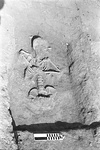| Collection: | Corinth | |
| Type: | Basket | |
| Name: | NB986 B2 P14 | |
| Area: | Panaghia north | |
| Category: | Basket/zembil | |
| Notebook: | 986 | |
| Context: | 2 | |
| Page: | 14 | |
| Date: | 2007/04/20 | |
| Stratum: | Burial, light, reddish-brown, silty, 2% inclusions, well sorted, pebbles | |
| Notes: | A pass to explore and remove the burial discovered during the cleaning basket (B 1): grave 2007-1. This burial is described on pages 16-17. No associated grave goods were found with this burial, though we uncovered a very small amount pottery and two iron nails. These objects are likely associated with the fill into which the grave was cut. Once the fill of the grave and the remains were removed, we closed the basket. Grave 2007-1 is a primary articulated burial in an oval pit located c. 2.5 meters south of west of W 296, taken from the northwest corner of the wall. This places the burial within the western part of the 16th to 18th century AC cemetery in Panaghia Field. The cuttings for the burial were discovered during the initial cleaning of the trench (B 1), and the presence of human remains was suggested by an aligned long bone, which later proved to be part of burial 2007-2, itself situated within the eastern portion of pit 2007-2. The pit for this burial is 2.00 m long by .80 m wide, and the body, preserved only from the top of the cranium to the pelvis, measures .66 m long by .40 m wide. Stratigraphically, the pit is at 91.921 m at its top elevation and 91.735-91.651 along its bottom elevation. The pit slopes downwards toward the east. The burial was excavated by Tasos Kakouros and Thanasis Mangorakis on the 20th and 23rd of April, 2007. The bones are in poor condition and not complete. The skeleton appears to have been cut below the pelvis by later activity, leaving only the joint surfaces of the femurs, though the nature of this cutting is uncertain; there has also been a inferior/dorsal displacement of the maxilla, only c. 40% complete, and the frontal bone as well as the entirety of the left and the majority of the right zygomatic processes are missing, perhaps due to activity after the burial. The grave cut was discovered before its excavation, and so the majority of post mortem breaks occurred between the time of burial and the time of excavation. The fracture of the right arm bones in the vicinity of the elbow may have been the result of activities by the excavators. The body is supine with its head to the west. The head may originally have been propped up, as suggested by a small stone found in the vicinity of the sternum and perhaps used to raise the chin when the body was interred. The mandible has been dislocated and is now situated just above the sternum. The displaced and shattered maxilla now rests above the mandible. The upper portion of the left arm flares out from the torso and the elbow is bent at roughly 45˚ so that the lower arm and hand rest on the lower extremity of the rib cage. The right arm has been displaced, so that the humerus extends almost horizontally at the level of the maxilla, with the radius turning at about 90˚ back toward the chest. This configuration may indicate that the body was arranged prior to burial and then moved in a sheet or similar object, causing the body to shift before its final placement. The measurement taken over the spine was 98˚ east of north with a cutting for the burial at 92˚ east of north. The skeleton is not situated tightly within the grave cut, with the elbow of the left arm almost .09 m inside of the cutting. The pelvis also appears to have been displaced, with the top of the left ilium situated c. .05 m above the top of the right ilium. The feet presumably would have been oriented toward the east, though they are now absent, having likely been disturbed by the cutting that runs on a north-south axis (416.4 E) across the burial just below the pelvis. Associated objects: None | |
| Context Pottery: | Fineware. pre-ottoman 3 | |
| Pottery Summary: | 6 frag(s) 0.04 kg. (0% saved) fineware. | |
| 56 frag(s) 0.71 kg. (0% saved) coarseware. | ||
| 11 frag(s) 0.08 kg. (0% saved) cooking ware. | ||
| Context Artifacts: | sombrero lid rim 1; lamp type 27 bs 2; iron nail square shank 1; tile c. 15 | |
| Period: | Turkish I (1458-1680 AD) | |
| Chronology: | early Ottoman | |
| Grid: | 417.41-415.182E, 978.525-979.542N | |
| XMin: | 415.182 | |
| XMax: | 417.41 | |
| YMin: | 978.525 | |
| YMax: | 979.542 | |
| Site: | Corinth | |
| City: | Ancient Corinth | |
| Country: | Greece | |
| Masl: | 91.615-91.921m. | |
| References: | Images (4) |
|
Show Everything (259,852) Publications (1,214) Reports (75) Places and Monuments (297) Plans and Drawings (2,887) Images (88,930) Objects (70,348) Coins (18,459) Notebooks (443) References Images (4) Classifications Sign in Provide feedback |
|

